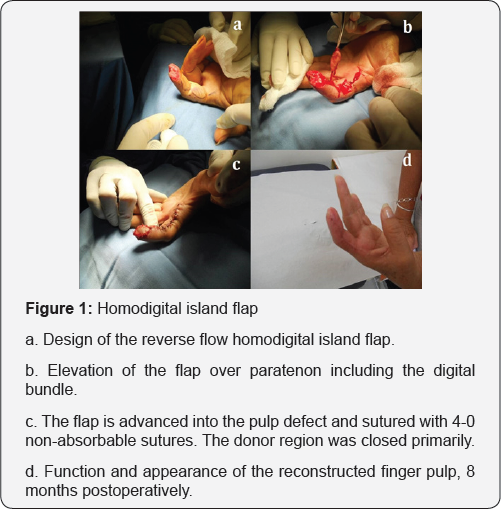Reverse Homodigital Island Flap in Fingertip Reconstruction
*Ricardo Monreal
Centro Medico MEDEX, San Isidro, USA
Submission: April 22, 2017; Published: May 02, 2017
*Corresponding author: Ricardo Monreal, Centro Medico MEDEX, San Isidro Lima, Peru, USA, Email: rmonreal59@yahoo.es
How to cite this article: Ricardo M. Reverse Homodigital Island Flap in Fingertip Reconstruction. Ortho & Rheum Open Access 2017; 6(4): 555692. DOI: 10.19080/OROAJ.2017.06.555692
Introduction
Digital pulp loss is a very common situation in hand trauma. One of the mostly commonly used classifications of fingertip amputations is the Tamai classification [1] in which the distal phalanx is divided into two regions. The region between the nail bed and distally to the fingertip is classified as Zone 1, and the zone between the nail bed and proximally to the distal inter phalangeal joint is designated as Zone 2. Although replantation is the best treatment method, it may not always be possible [2].
Discussion
The ideal reconstruction following fingertip loss provides bulk when necessary, a durable sensate tip with no donor site morbidity and with preservation of length. Skin grafts or uninervate flaps give a poor surgical result in functional terms, with little restoration of local sensitivity.
A wide choice of flap exists when there is tissue loss with exposed bone or tendon:
A. Distant flaps (as the nar flap, arm flap, etc.) involve two stage procedure with their obvious disadvantages.
B. Finger flaps may be harvested from the same finger (homodigital) or an adjacent finger (heterodigital). Pedicled flaps may be ante grade or retrograde (reversed flow).
C. Vascularized free toe pulp can be used for extensive pulp loss.
In cases of bone or tendon exposition, initial options might be local flaps, such as the V-Y flap [3,4]. When the use of local advancement flaps is not possible because there is a great tissue loss of the pulp the reverse flow homodigital island flap [5] provides acceptable aesthetic results and is performed as a single surgical procedure.
The homodigital island flap can be dissected under loupe magnification and permit early active motion, a desirable feature in acute injuries. Micro vascular technique is helpful but not an absolute prerequisite. The flap is separated from the sheath of the flexor tendons, from the distal to proximal direction, in the central part of the finger. Next, the neurovascular pedicle is dissected to include the greatest quantity possible of fibro adipose tissue, in order to increase venous drainage. The collateral nerve and the pal mar digital artery of the digit face are included. The flap is transposed and attached to the margins of the recipient area. The skin overlying the neurovascular pedicle (longitudinal incision) is sutured. The donor region was closed primarily (Figure 1).

One stage local island flaps are preferred to multistage regional flaps because of shorter hospital stays, lower cost, and minimal disability time [6]. In 1973 Weeks and Wray [7] first applied the distally based arterial island flap for fingertip reconstruction. Later a similar flap, the reverse digital artery flap, was designed by Kojima et al. [8] and Lai et al. [5] but the sensation of the digit was not restored. Gradually improvements were made in the reverse digital artery flap. In 1989 Foucher et al. [9] described the homodigital neurovascular island flap for digital pulp loss that could reconstruct sensate pulp. Only in cases of complete amputations of the digital pulp when the use of local or distant flaps is impossible, the free transfer of the toe pulp is indicated [10].
Conclusion
The reverse flow homodigital island flap provides a method for a one-stage reconstruction of finger pulp defects restoring sensation allowing early finger motion.
References
- Tamai S (1982) Twenty years experience of limb replantation-- review of 293 upper extremity replants. J Hand Surg Am 7(6): 549-556.
- Dautel G, Barbary S (2007) Mini replants: fingertip replant distal to the IP or DIP joint. J Plast Reconstr Aesthet Surg 60(7): 811-815.
- Goubier JN, Teboul F (2007) Atasoy flap. Interact Surg Am 2(2): 116117. This work is licensed under Creative Commons Attribution 4.0 License DOI: 10.19080/OROAJ.2017.06.555692
- Shepard GH (1983) The use of lateral V-Y advancement flaps for fingertip reconstruction. J Hand Surg Am 8(3): 254-259.
- Lai CS, Lin SD, Yang CC (1989) The reverse digital artery flap for fingertip reconstruction. Ann Plast Surg 22(6): 495-500.
- Yan Feng Li, Shu Sen Cui (2005) Innervated reverse island flap based on the end dorsal branch of the digital artery: Surgical Technique. J Hand Surg Am 30(6): 1305-1309.
- Weeks PM, Wray RC (1973) Management of acute hand injuries. A biological approach. (2nd edn), Mosby Co, St Louis, USA, pp. 140-143.
- Kojima T, Tsuchida Y, Hirase Y, Endo T (1990) Reverse vascular pedicle digital island flap. Br J Plast Surg 43(3): 290-295.
- Foucher G, Smith D, Pempinello C, Braun FM, Citron N (1989) Homodigital neurovascular island flaps for digital pulp loss. J Hand Surg Br 14(2): 204-208.
- Deglise B, Botta Y (1991) Microsurgical free toe pulp transfer for digital reconstruction. Ann Plast Surg 26(4): 341-346.






























